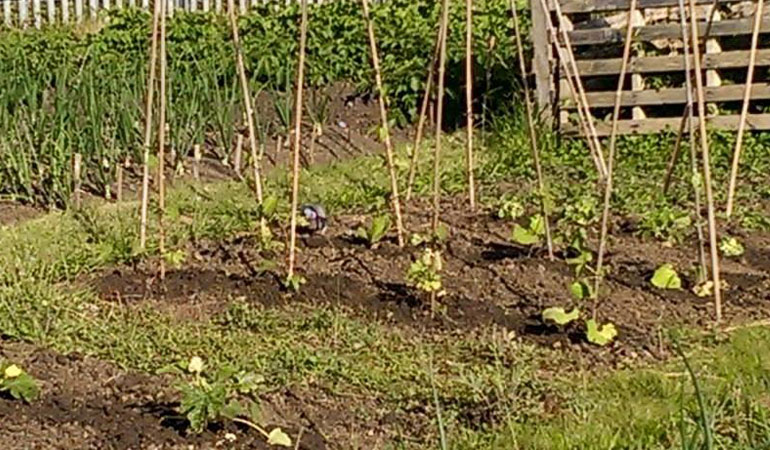Make the Most of Your Growing Space

I gave up my plot last year with a view to expanding my vegetable patch at home and making as much use as I could of that space. Here’s a brief account of my efforts in this respect.
My vegetable patch consists of a 6’ x 6’ greenhouse, about 25 square yards of raised beds and a reasonable size fruit patch, in all about 40 square yards. I also have a large south-facing patio with 15 to 20 large containers and room for a small plastic covered plant house. If we take account of sheds, paths, etc., this is probably just about a quarter of a plot. This reduction in growing space meant a rethink of my growing strategy to recognize that I cannot grow everything and need to concentrate on those crops which I like most or gave a good return.
I also set out to try and grow two crops per year on as much of the land as I could. In my quest for efficiency, I was helped by the purchase of “How to Grow Winter Vegetables” by Charles Dowding, a book stuffed with very valuable information and tips about when and what to grow to have vegetables to eat in winter and how to get summer crops off the same ground.
The strategy is as follows:
Can you afford to grow it?
You need to look at your intended crops and decide if their size, time in the ground and value to you make sense. Purple sprouting broccoli is in the ground for 44 weeks, is large and requires considerable protection. Squashes trail out all over the place and occupy lots of land. Carrots get root fly – can you prevent it or is another way better? Can you afford to grow maincrop potatoes, or should you just grow 1st/2nd earlies? The answers will be different for everyone but you do need to take a hard look before you buy those seeds.
Choose the right varieties
This means choosing seeds which fit into your intended sowing plan. You may choose early or late sown peas, a hardy type of lettuce, 1st early or late sown potatoes rather than main crop, etc.
Raise seeds in modules
This applies to the vast majority of seeds and allows you to protect the plants at the vital young stage and get them to a stage when they are less vulnerable to pests before planning out. You also gain anything up to 6 weeks for the preceding crop which can use that ground to grow to maturity.
Devise a plan & stick to it
Here you plan out what crops are to be grown, where and when. As you are planting out from modules rather than sowing seeds, crops are planted out 3 to 6 weeks after sowing but you do need to include sowing them in the plan. What is really important is to know when crops will be finished and beds ready for the next crop, so put dates on your plan as things develop and this will pay off next year.
Protect your crops
Protection in the form of poly-tunnel or greenhouse for seed raising, polythene, fleece or cloches for plant growing enable you to gain further time for early starts or late finishes to your crops. Fleece can extend your season by a month both early and late.
Keeping fertility going by mulching for each crop
This step assumes you operate a no-dig regime, mulching the ground each time you plant with about 2 to 4 cm of compost and allowing the worms to drag it down into the soil over the coming months. Compost/manure (well-rotted) could be dug in but this will make changes of crops much more onerous as time to settle is needed.
Grow crops in containers if you can provide a decent microclimate
I’ve experimented with very early and overwintering crops in buckets in the cold greenhouse – autumn onion sets 1” apart made great salad onions in April/May, Amsterdam Forcing carrots made very early small sweet carrots and a late crop will be tried, 1st early potatoes, late cropping potatoes, radishes, lettuce, oriental leaf crops, etc. are all candidates for additional use of a greenhouse or grow house.
I’ve tried this strategy for this year (2012) and it does appear to give very good results although the weather has been far from helpful. My growing spaces were in use earlier this year than normal and all have been full from late May and will hopefully remain full for as long as possible. Having seen the strategy in action, I now realise that you can develop schemes of vegetable sowing which suit your own purposes in terms of crop type and how much ground you want to use for them, then use different beds each year to give some semblance of a crop rotation. Ideas for scheme constituents are:
Feb-May
Early peas (meteor, Feltham First), salad crops (including buckets)*
Mar-Jun
Early potatoes, salads. Maincrop peas (hurst greenshaft), overwintering autumn onions*
Mar-Jul
Maincrop onions
Apr-Jul
As Mar-Jun
Jun-Sep/Oct
Runner beans, sweetcorn, french beans, tomatoes, cucumber, salads, late peas, salads, beetroot
Jul-Sep
Late peas (Ambassador, Kenobi), salads, french beans, runner beans, sweetcorn, etc.
Jul-Dec
Swede, late cauliflower, cabbage
Jul-May
Kale, spring cabbage, perpetual spinach, chard, etc.
Aug-Nov+
late salads, oriental greens & radishes/ late potatoes/ winter greens, etc.*
Oct-Jun
Garlic/autumn onions sets, late salads in buckets*
Nov-May
Broad beans* to follow courgettes, tomatoes, sweetcorn
* need protection
This list can be modified for your own needs and schemes of planting put together accordingly. One scheme I’ve devised is: Mar-Jun, early potatoes; Jul-Sep, late peas; Oct-Jun, garlic/autumn onions; Jul-Oct; sweetcorn (late); Nov-May, broad beans; Jun-Sep, tomatoes. This is 6 crops in 2 ½ years! Areas needed for crops will vary in extent so Jul-Sep might be half peas and half french beans or different pea varieties.
To sum up – organisation, module sowing, protection & fertility!
Philip Drew
